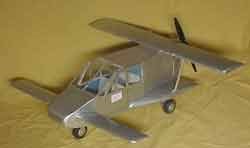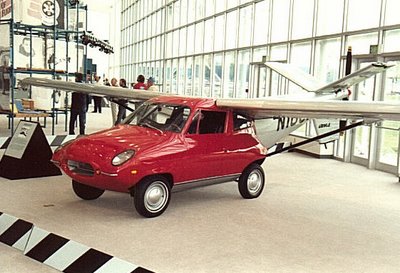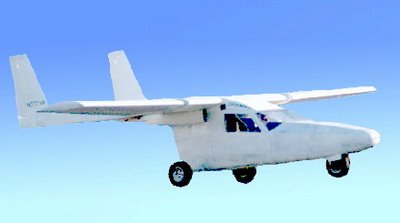
This summer, graduate students at the Massachusetts Institute of Technology will try to get an idea aloft that has intrigued people for decades: the flying car.
Terrafugia, a start-up created by Lemelson-MIT Student Prize winner Carl Dietrich and colleagues at MIT's Department of Aeronautics and Astronautics, is aiming to show off what it calls the Transition "personal air vehicle," a vehicle resembling an SUV with retractable wings, to the EAA AirVenture Conference in Oshkosh, Wis., at the end of July.
The Transition is designed for 100- to 500-mile jumps. It will carry two people and luggage on a single tank of premium unleaded gas. It will also come with an electric calculator (to help fine-tune weight distribution), airbags, aerodynamic bumpers and of course a GPS (Global Positioning System) navigation unit.
The company hopes to eventually have the vehicle classified so that it can be piloted with a light sport aircraft license.
No complete prototype exists yet, but the company has a one-fifth scale wind tunnel model (along with computer simulations) and will use the $30,000 from the Lemelson prize to build something to show off at the Oshkosh show. A fully operational prototype is expected to come out in 2008 or earlier, according to the company, while Transition vehicles are expected to hit the road, and the sky, by 2009 or 2010.
"We have a lot of confidence that if the interest is there, we can deliver this product," Dietrich said. "There is a huge amount of general interest, but the question is, is there a market for it?"

Building retractable wings won't be the major challenge: F-18s and even some World War II era planes have folding wings. Instead, one of the biggest challenges will be creating enough cargo room to satisfy customers. The planes, which will cruise up to 12,000 feet, will probably use an off-the-shelf engine, he added.
In the past few years, the skies have become a new frontier for entrepreneurs and academics. The chase for the X Prize led entrepreneur Richard Branson and others to begin to contemplate space tourism. PayPal founder Elon Musk, meanwhile, has started SpaceX, a private company that hopes to launch rockets for satellite deployment, similar to the more heavily funded Sea Launch venture. Stanford University professors teach a course on do-it-yourself satellites.
Short-range aircraft and flight start-ups have sprung up as well. Citrix founder Ed Iacobucci has launched DayJet, which plans on buying a fleet of Eclipse planes for on-demand travel between regional hubs. People Airlines founder has a similar company based on the small, lightweight Eclipse. (Microsoft Chairman Bill Gates is an investor in Eclipse.)
And for backyard adventurers, Elwood "Woody" Norris has the AirScooter, a personal helicopter. Graduate students at Stanford also have hatched a secretive start-up geared at recreational flyers, according to sources familiar with their plans.
Flying cars are technically feasible; Terrafugia points out that inventor Molt Taylor built prototypes in the 1950s and 1960s--but they haven't been practical from an economic perspective.
The picture has changed, however, with the development of lighter and stronger construction materials and more efficient engines. Terrafugia is aiming to build a vehicle that will fly at 120 miles per hour and get 30 miles a gallon in the air. (It will also get 40 miles per gallon on the freeway and 30 in the city).
The Transition vehicle will carry a payload of only 430 pounds, far less than cars, but how many cars can take flight after 1,500 feet of takeoff space?
Demand also has finally begun to emerge. Today's clogged freeway traffic and dispersed suburban living patterns have created an audience for these types of vehicles. Regional airports are also somewhat plentiful and underutilized. In addition, Federal Aviation Administration regulations passed in 2004 have made it easier to get a sport pilot's license.
"Since 9/11, for the first time, average door-to-door travel speed has really dropped substantially due to a combination of increased security measures at airports and more road traffic," Dietrich said in a statement accepting the Lemelson prize.
The Lemelson foundation, named after controversial inventor and patent litigant Jerome Lemelson, gives an annual student award, as well as lifetime awards, to inventors. Past winners of the student prize included James McLurkin for his work on swarming robots. Lifetime achievement winners included Segway inventor Dean Kamen.
The foundation cited Dietrich, one of the star students in the department, for other accomplishments. Dietrich also holds a patent for the Centrifugal Direct Injection Engine, a low-cost, high-performance rocket propulsion engine. For his doctoral work, he is researching how a fusion reactor could be used to power a spacecraft.
CNet













